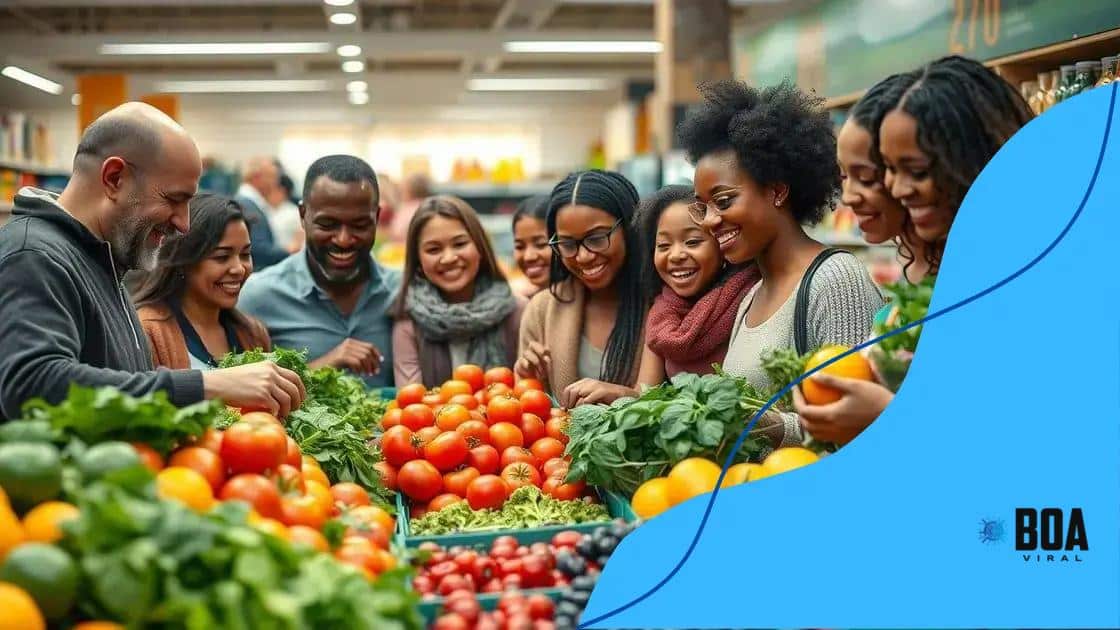Supplemental Nutrition Assistance Program (SNAP) updates you need to know

The Supplemental Nutrition Assistance Program (SNAP) provides financial assistance for food purchases to eligible low-income individuals and families, helping them access nutritious meals.
Supplemental Nutrition Assistance Program (SNAP) updates are crucial for individuals seeking assistance with food security. Staying informed about these updates can significantly impact your access to resources and support. Have you checked the latest changes that might benefit you or someone you know?
What is the Supplemental Nutrition Assistance Program (SNAP)?
The Supplemental Nutrition Assistance Program (SNAP) is a vital initiative designed to help individuals and families access nutritious food. It provides financial assistance for purchasing food, making it essential for many households. Understanding this program is crucial for those who may qualify or need support.
How SNAP Works
SNAP benefits are delivered through an Electronic Benefit Transfer (EBT) card, which works like a debit card. Eligible participants can use this card to buy food at approved retailers. The amount of benefits you receive depends on various factors, including household size and income.
Eligibility Requirements
To qualify for SNAP, you must meet certain criteria, including:
- Being a U.S. citizen or a legal resident.
- Meeting income requirements based on household size.
- Willingness to provide information about your expenses and resources.
It’s important to check local regulations, as they can vary by state. Applying for SNAP is straightforward. Interested individuals can visit their state’s SNAP office or website for more information. You will need to provide documentation such as identification and proof of income.
Benefits of SNAP
Participating in SNAP not only helps families secure food but also supports local economies. When families use their benefits, they often shop at local stores. This can create jobs and stimulate economic growth in communities.
Moreover, SNAP improves access to nutritious meals, helping recipients maintain a balanced diet. Through education and resources available in conjunction with SNAP, individuals can learn about healthy eating and budgeting, leading to healthier choices.
In summary, the Supplemental Nutrition Assistance Program (SNAP) is a crucial resource for many. It serves as a safety net, ensuring that individuals and families can access the food they need to thrive in their communities.
Recent changes to SNAP benefits in 2023
In 2023, there have been significant changes to SNAP benefits that aim to improve food access for eligible individuals and families. These updates can impact many households, making it essential to stay informed about the latest developments.
Increased Benefit Amounts
This year, the Department of Agriculture has increased the maximum benefit allotments for SNAP programs to address rising food prices. Families may see an uptick in their monthly benefits, helping them purchase more nutritious items.
Temporary Emergency Benefits
Another important update is the continuation of temporary emergency benefits that were implemented during the pandemic. Many states are allowing these extended benefits to help cover food expenses due to inflation and economic hardship.
- Emergency allotments provide additional funds each month.
- They help households afford healthier food options.
- This assistance is especially crucial for low-income families.
Furthermore, eligibility requirements have been adjusted to help more families qualify for assistance. Income limits may vary by household size, so it’s advisable for applicants to check their specific situation.
Some states are also introducing streamlined applications to make it easier for potential beneficiaries to enroll and access support. This means fewer barriers and faster processing times, allowing families to receive assistance when needed.
The recent changes to SNAP benefits in 2023 reflect ongoing efforts to enhance food security and access to healthy foods in communities. By staying updated on these changes, individuals can better navigate the resources available to them.
How to apply for SNAP benefits

Applying for SNAP benefits can seem daunting, but the process is straightforward if you follow these steps. Many people may need assistance, and understanding how to apply is the first step toward accessing essential food support.
Check Your Eligibility
Before applying, it’s important to check if you meet the eligibility requirements. You can find this information on your state’s SNAP website. Common factors include your household size, income, and expenses.
Gather Necessary Documentation
Once you confirm your eligibility, gather the necessary documents. Typically, you’ll need:
- Proof of identity, such as a driver’s license or ID card.
- Income verification, which can include pay stubs or tax returns.
- Proof of residency, such as a utility bill or lease agreement.
Having these documents ready will make the application process smoother.
How to Submit Your Application
There are different ways to submit your application, depending on your state:
- Online: Most states offer an online application portal.
- By mail: You can download a form, fill it out, and mail it to your local SNAP office.
- In-person: Visit your local SNAP office to apply directly.
Make sure to check for deadlines, as some states may have specific timelines for processing applications.
After applying, you may be required to attend an interview. This interview helps verify the information you provided and answers any questions about your application. During the interview, be prepared to discuss your household situation and provide any additional required information.
Finally, it’s essential to stay informed about the status of your application. You can typically check your application status online or by calling your local SNAP office if you have questions.
Eligibility requirements for SNAP assistance
Understanding the eligibility requirements for SNAP assistance is essential for those seeking food support. Each state has specific guidelines, but several common factors help determine who can apply.
Basic Eligibility Criteria
To qualify for SNAP, applicants generally must meet these basic criteria:
- Be a legal U.S. resident or citizen.
- Meet income limits based on household size.
- Have limited resources, such as savings or cash.
The income limits are often set as a percentage of the federal poverty level and can vary by state.
Household Composition
Another important aspect is household composition. A household may include individuals related by blood, marriage, or other living arrangements. It’s crucial to report all members accurately, as this affects benefits.
Students, elderly individuals, and those with disabilities may have different eligibility requirements or considerations. For example, many students may not qualify unless they meet specific criteria.
Resource Limits
Most households must have resources below a certain limit to qualify. Resources can include cash, bank accounts, and other assets. However, some types of resources, like a home or retirement accounts, are not counted.
It’s essential to evaluate your situation carefully. If you think you might be eligible, check with your state’s SNAP program for detailed information on how to apply and what documents you will need.
By understanding the eligibility requirements for SNAP assistance, individuals and families can navigate the application process more effectively and access the food support they need.
Tips for maximizing your SNAP benefits
Maximizing your SNAP benefits can significantly enhance your ability to access nutritious food. By utilizing your benefits wisely, you can stretch your monthly budget and ensure you have enough to feed your household.
Understand What You Can Buy
First, it’s crucial to know what items are eligible for purchase with your SNAP benefits. Generally, you can buy:
- Fruits and vegetables.
- Meat, poultry, and fish.
- Dairy products.
- Breads and cereals.
Avoid using your benefits for non-food items, including household supplies and personal care products.
Plan Your Meals
Meal planning can help you use your benefits more effectively. By planning meals for the week, you can create a shopping list that helps you avoid impulse buys. Try to focus on recipes that use ingredients you already have at home to minimize costs.
Additionally, consider batch cooking. Preparing larger quantities of meals can save time and money, allowing you to eat well throughout the week without having to spend more.
Shop Smart
When shopping, use coupons and promotions to get the most out of your SNAP benefits. Many stores offer discounts on specific items, and some even have loyalty programs that can provide additional savings.
Also, consider shopping at farmer’s markets, where you may find fresh produce at lower prices. Some markets even accept SNAP benefits, allowing you to directly support local farmers.
Take Advantage of Resources
Finally, there are resources available to help you maximize your SNAP benefits. Look for local organizations that offer nutrition education classes. These programs can teach you how to prepare healthy meals and budget your food spending.
By following these tips, you can make the most of your SNAP benefits and improve your food security. Remember, being informed and planning ahead are key steps toward better nutrition.
In conclusion, understanding and maximizing your SNAP benefits is key to accessing nutritious food and improving food security. By checking your eligibility, gathering necessary documents, and utilizing resources, you can ensure that you make the most of the assistance available. Meal planning and shopping smartly can help stretch your benefits further. Remember, these programs aim to support you and your family in maintaining a healthy lifestyle.
FAQ – Frequently Asked Questions about SNAP Benefits
What are SNAP benefits?
SNAP benefits provide financial assistance for purchasing food for eligible low-income individuals and families.
Who is eligible for SNAP benefits?
Eligibility varies by state but generally includes requirements related to income, household size, and citizenship status.
How can I apply for SNAP benefits?
You can apply online, by mail, or in-person at your local SNAP office. Check your state’s website for specific instructions.
What foods can I buy with SNAP benefits?
You can use SNAP benefits to purchase eligible food items such as fruits, vegetables, meats, dairy, and bread, but not non-food items.






